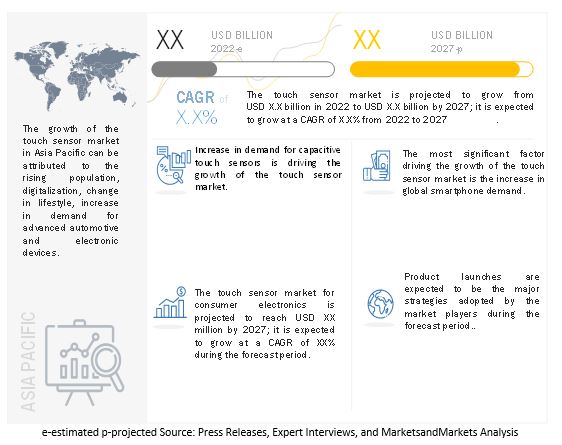Touch Sensor Market - Global Forecast 2024 to 2030
A touch sensor, also known as tactile sensors is an electronic sensor used to detect and record physical touch. These sensors are economical miniature-sized alternatives to traditional mechanical switches. They are widely used for smartphones, displays, robotics, automotive, smart homes, and industrial applications.
The global touch sensor market size is expected to grow from USD XX million in 2024 to USD XX million by 2030, at a CAGR of XX%. The increasing usage of touch sensors in portable electronics devices such as smartphones, smart TVs, and tablets and the growing demand for interactive digital signage in retail stores and malls are the key factors boosting the growth of the market.

To know about the assumptions considered for the study, Request for Free Sample Report
Drivers: Increase in use of touch sensors in portable electronic devices and automotive
Touch sensors are widely used in various portable electronic devices such as smartphones, wearables, tablets, laptop screens, and smart TVs. In automotive, they are used in infortainment systems to enhanced user experience. The increase in demand for the electronic devices and automotive is driving the growth of the touch sensors market.
Drivers:Increased integration of touch sensors in smart medical devices
Smart medical devices integrated with touch sensors are gaining traction now-a-days. They has advanced computing and communication technologies that aids in monitoring, collecting, and transmiting patient data to provide better diagnostics and treatment decisions. In addition, wearable devices transmit critical medical data in real time from hospital beds and private homes to physicians, which aids in accurate and on-time treatment. Moreover, adoption of touch sensors for therapeutic treatments is also increased driving the demand for touch sensors.
Challenges: Designing and testing challenges associated with touch sensors
The development of capacitive touch sensor face various designing and testing challenges such as grounding design, false touch, and EMI testing. Stable grounding design is critical to making sure that projected capacitive (PCAP) displays work properly. In addition, touch sensors are highly sensitive and touch screens ae prone to scratches. This may affect the functioning of the touch sensor and result in false touch.
Key players in the market
Infineon Technologies AG (Germany), Siemens (Germany), On Semiconductor (US), Texas Instruments Incorporated (US), Honeywell International (US), NXP Semiconductor N.V. (Netherlands), Qualcomm Inc. (US) STMicroelectronics N.V. (Switzerland), Microchip Technology Incorporated (US), and Banpil Photonics (US) are few key players in the touch sensor market globally.
Recent Developments
- In December 2021, Infineon Technologies AG launched the company’s fifth-generation CAPSENSE capacitive and inductive touch sensing human-machine interface (HMI) technology. It delivers higher performance and lower power consumption for demanding user interfaces in home appliance, industrial, consumer and IoT products.
- In December 2020, Renesas Electronics Corporation expanded its 32-bit RA2 Series microcontrollers (MCUs) with 20 new RA2L1 Group MCUs, increasing the RA Family to 66 MCUs. The RA2L1 MCUs are designed for ultra-low power consumption, with several integrated features to lower BOM costs, including capacitive touch sensing, embedded flash memory densities up to 256 KB, SRAM at 32 KB, analog, communications, and timing peripherals, and safety and security functions.
- In April 2020, Infineon Technologies AG had acquired Cypress Semiconductor Corporation. The acquisition will broaden their application range as well as improve their product offerings such as sensors and others.

TABLE OF CONTENTS
1 Introduction
1.1. Study Objectives
1.2. Market Definition
1.2.1. Inclusions and Exclusions
1.3. Study Scope
1.3.1. Markets Covered
1.3.2. Geographic Scope
1.3.3. Years Considered
1.4. Currency
1.5. Limitations
1.6. Stakeholders
2 Research Methodology
2.1. Introduction
2.2. Research Data
2.2.1. Secondary Data
2.2.2. Primary Data
2.2.2.1. Breakdown Of Primary Interviews
2.2.2.2. Primary Interviews With Experts
2.2.2.3. Key Data From Primary Source
2.2.2.4. Key Industry Insights
2.3. Market Size Estimation
2.3.1. Bottom-UP Approach
2.3.2. Top-Down Approach
2.4. Market Breakdown and Data Triangulation
2.5. Research Assumptions
3 Executive Summary
4 Premium Insights
5 Market Overview
5.1. Introduction
5.2. Market Dynamics
5.2.1. Drivers
5.2.2. Restraints
5.2.3. Opportunities
5.2.4. Challenges
5.3. Value Chain Analysis
5.4. Case Study
5.5. Average Selling Price (ASP) Analysis
6 Touch Sensor Market, By Technology
6.1. Introduction
6.2. Resistive
6.3. Capacitive
6.4. Infrared
6.5. Others
7 Touch Sensor Market, By Product
7.1. Introduction
7.2. Smartphones
7.3. Tablets
7.4. Monitors & Laptops
7.5. Interactive Screens
7.6. Others
8 Touch Sensor Market, By Application
8.1. Introduction
8.2. Consumer Electronics
8.3. Retail
8.4. Education
8.5. Others
9 Touch Sensor Market, By Region
9.1. Introduction
9.2. North America
9.2.1. US
9.2.2. Canada
9.2.3. Mexico
9.3. Europe
9.3.1. Germany
9.3.2. France
9.3.3. UK
9.3.4. Rest of the Europe
9.4. Asia Pacific
9.4.1. China
9.4.2. Japan
9.4.3. India
9.4.4. South Korea
9.4.5. Rest of Asia Pacific
9.5. Rest of World (RoW)
9.5.1. South America
9.5.2. Middle East
9.5.3. Africa
10 Competitive Landscape
10.1. Overview
10.2. Market Evaluation Framework
10.2.1. Product Portfolio
10.2.2. Regional Focus
10.2.3. Manufacturing Footprint
10.2.4. Organic/Inorganic Strategies
10.3. Market Share Analysis (Top 5 Players)
10.4. 5-Year Company Revenue Analysis
10.5. Company Evaluation Quadrant
10.5.1. Stars
10.5.2. Emerging Leaders
10.5.3. Pervasive
10.5.4. Participants
10.5.5. Competitive Benchmarking
10.6. Company Footprint
10.6.1. Company Technology Footprint
10.6.2. Company Product Footprint
10.6.3. Company Region Footprint
10.7. Competitive Situation and Trends
10.7.1. Product Launches
10.7.2. Deals
11 Company Profiles
11.1. Introduction
11.2. Key Players
11.2.1. Infineon
11.2.2. Siemens
11.2.3. On Semiconductor
11.2.4. Texas Instruments
11.2.5. Honeywell
11.2.6. Atmel
11.2.7. NXP Semiconductor
11.2.8. Qualcomm Inc
11.2.9. STMicroelectronics
11.2.10. Microchip Technology
11.3. Other Key Players
11.3.1. Banpil Photonics
11.3.2. 3M Touch Systems
11.3.3. Cypress Semiconductor
11.3.4. Samsung Electronics
11.3.5. TPK Holding
11.3.6. Fujitsu
11.3.7. Freescale Semiconductor
11.3.8. Neonode
11.3.9. Corning Incorporated
11.3.10. Immersion Corporation
12 Appendix















Growth opportunities and latent adjacency in Touch Sensor Market